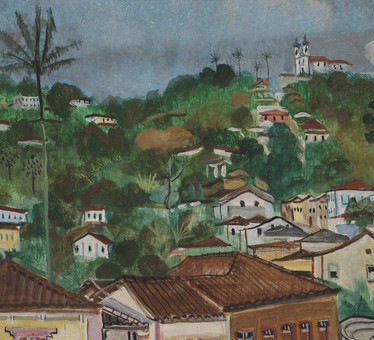Alberto da Veiga Guignard

Nova Friburgo, Brazil, 1896 —
Belo Horizonte, Brazil, 1962
Alberto da Veiga Guignard breathes a moving freedom over Brazilian modernism of the 1920s and 1930s. Moving away from heroic nationalist pretensions, his work investigates subtle atmospheres: subjectivity, relative distances, the frayed temporality of memory, dream and illusion .
Born in 1896, Alberto Guignard moved as a child with his mother and stepfather to Europe, where he lived all his childhood and youth, definitively returning to Brazil only in 1929. Between the years 1917 and 1918 and between 1920 and 1921, Guignard studied at the Royal Academy of Fine Arts in Munich, immersed in the European pictorial production of the Renaissance and witnessing the work of the avant-garde. Such experience, in addition to giving the artist a remarkable technical mastery and familiarity with historical conceptions and issues in painting, contributed to his performance as a teacher, first at the Osório Foundation, in Rio de Janeiro, between 1931 and 1943 and then, between 1944 and 1962, at the Belo Horizonte School of Fine Arts, today Guignard School. It is notable that, in contrast to the strict treatment of European masters, Guignard married sharp critical attention with good humor and confidence in the sensitivity of the students, creating an environment of healthy autonomy that attracted students such as Iberê Camargo, Amilcar de Castro, Mary Vieira and Lygia Clark.
Guignard’s work is marked by a dynamic and widespread development, of advances and setbacks, freely interconnecting his interests. It is noted, however, that his production is articulated in academic genres: the portrait, the still life, the sacred painting and the landscape. These axes are found in a happy way, for example, in works such as Portrait of Felicitas Barreto (1931), Still-Life (1936) and The Twins (1940). The interpenetration of the themes may even suggest a certain symbolic aspect that each of them takes on in Guignard’s work. In the portrait of Felicitas Barreto, the craggy sea of mountains that forms the background of the model’s profile allows one to glimpse, very quickly, through the green of those steady eyes, like windows to the restless subjectivity retained by the physical delicacy of the young German dancer. The very height that the landscape occupies on the screen, around the girl’s head, refers to the psychological world, an intimate dimension of the portrait.
It is even the landscapes that mark the production of the last ten years of Guignard’s life. Ouro Preto, the eternal city of Minas that received the painter as a true son, fertilizes the imagined landscapes of the 1950s and 1960s. Far from the western dictate of landscaping supported by the shape of the linear perspective, Guignard seems to dialogue with techniques from the far east and builds landscapes a at once aerial and frontal, involving the observer in atmospheres as playful as they are mysterious. They are landscapes lovingly alive in their dubiousness: colorful at the same time happy and gloomy, churches, balloons and tiny characters, minimal portraits of everyone who shares a fragile and so fleeting world that we do not know if it is gone, if it came to be.
GGS